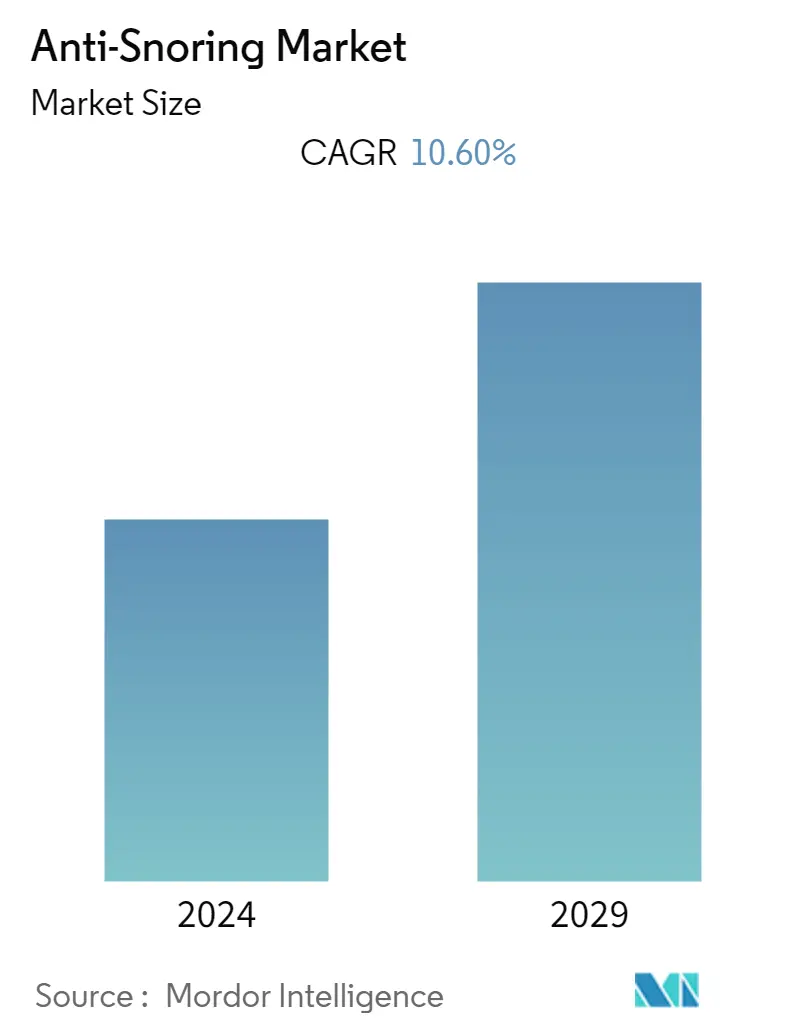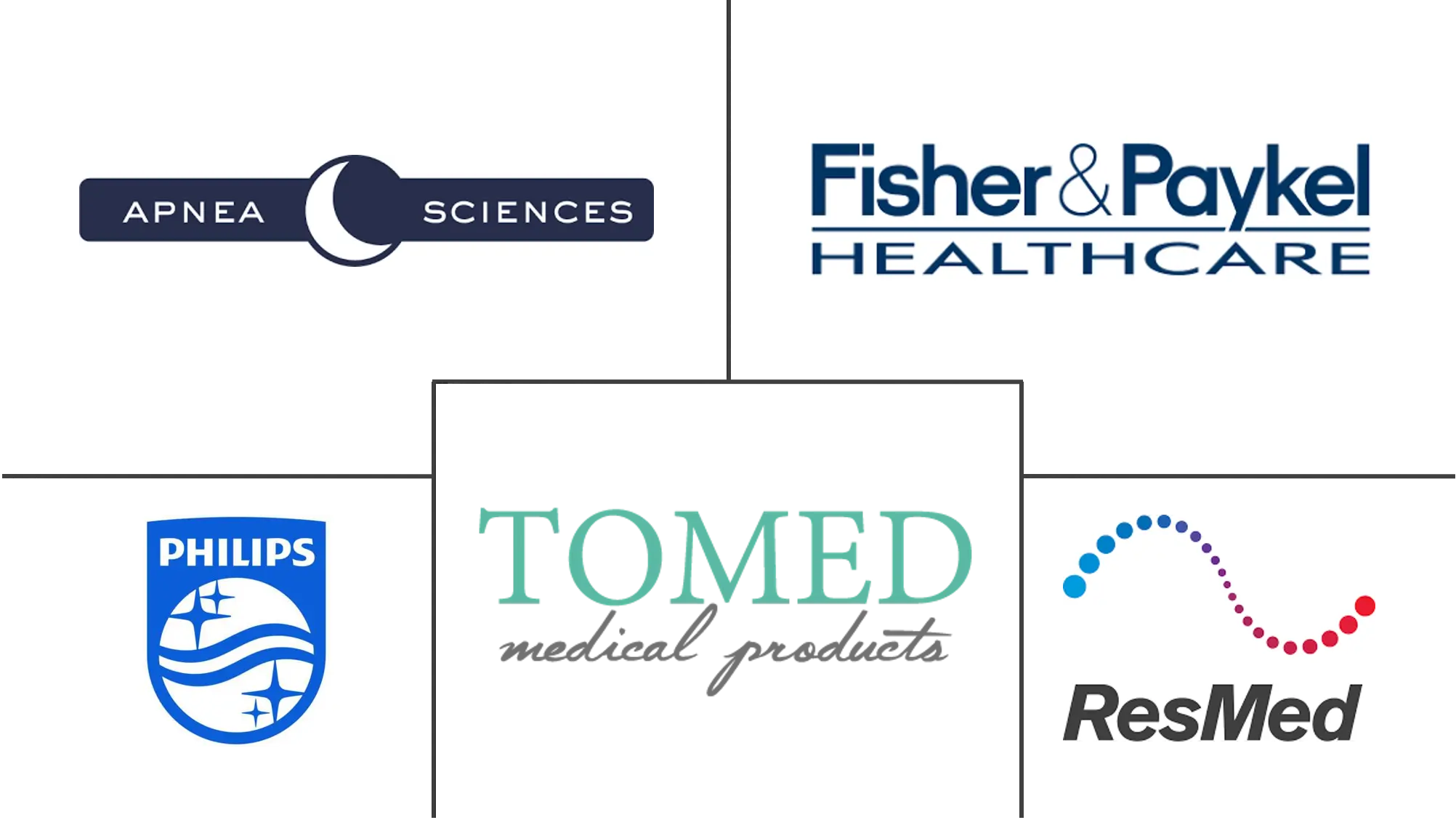Market Size of Anti-Snoring Industry

| Study Period | 2019 - 2029 |
| Base Year For Estimation | 2023 |
| CAGR | 10.60 % |
| Fastest Growing Market | Asia Pacific |
| Largest Market | North America |
| Market Concentration | Medium |
Major Players
*Disclaimer: Major Players sorted in no particular order |
Anti-Snoring Devices Market Analysis
The anti-snoring market is expected to register a CAGR of 10.6% during the forecast period.
COVID-19 had a significant impact on the anti-snoring devices market owing to the high demand during the pandemic. Obstructive sleep apnea was reported to increase the risk of morbidity and mortality associated with COVID-19. For instance, as per a research article published in December 2021 by Cleveland Clinic, people with COVID-19 who experience sleep-disordered breathing had a 31% higher likelihood of hospitalization. Hence, the demand for CPAP devices was high among hospitalized COVID-19 patients. COVID-19 has a negligible impact on the studied market in the current scenario.
An increase in obesity and the geriatric population, increasing smoking and alcohol consumption, technological advancements in anti-snoring devices, and increased awareness among the people are the key factors responsible for the growth of the market. For instance, according to the World Population Review 2022 data, around 29.4% of the people in Canada were affected by obesity. Weight gain is a major contributor to the habit of snoring because the peculiarities in weight gain affect the elderly population. Thus, the high prevalence of obesity among people is expected to boost market growth over the forecast period.
Furthermore, an article published in Statpearls updated in August 2022 stated that in the United States, tonsillectomy was one of the most commonly performed surgical procedures. Over 500 thousand cases are performed annually in children less than 15 years of age. Sleep-disordered breathing (SDB) is one of the most common reasons for tonsillectomy. Therefore, the large number of procedures is estimated to boost the demand for anti-snoring devices, such as tongue-retaining devices, which are required for the treatment of such diseases, thereby propelling the market growth during the forecast period.
Additionally, technological advancements and new product launches by market players are expected to propel market growth during the forecast period. For instance, in October 2021, Superior Sensor Technology launched a new dual low-pressure sensor product series for continuous PAP (CPAP), bi-level PAP (BiPAP), and automatic PAP (APAP) products used for sleep apnoea and other breathing sleep disorders. Therefore, owing to the factors such as the high burden of obesity, sleep disorders, and rising product approvals and launches by market players, the studied market is anticipated to witness growth over the analysis period. However, the high cost associated with custom-made oral devices and the social stigma associated with snoring are expected to restrain the market growth during the forecast period.
Anti-Snoring Devices Industry Segmentation
As per the scope of this report, anti-snoring treatment devices are defined as the equipment used to prevent snoring.
The Anti-Snoring Treatment Market is Segmented by Device Type (Mandibular Advancement Devices (MAD), Tongue Stabilizing Devices (TSD), Continuous Positive Airway Pressure (CPAP) Devices, and Other Device Types), Surgical Procedure (Uvulopalatopharyngoplasty (UPPP), Somnoplasty, Pillar Procedure, Tonsillectomy, Radiofrequency Palatoplasty, and Other Surgical Procedures), and Geography (North America, Europe, Asia-Pacific, Middle-East and Africa, and South America). The report offers the value (in USD million) for the above segments.
| By Device Type | |
| Mandibular Advancement Devices (MAD) | |
| Tongue Stabilizing Devices (TSD) | |
| Continuous Positive Airway Pressure (CPAP) Devices | |
| Other Device Types |
| By Surgical Procedure | |
| Uvulopalatopharyngoplasty (UPPP) | |
| Somnoplasty | |
| Pillar Procedure | |
| Tonsillectomy | |
| Radiofrequency Palatoplasty | |
| Other Surgical Procedures |
| Geography | ||||||||
| ||||||||
| ||||||||
| ||||||||
| ||||||||
|
Anti-Snoring Market Size Summary
The anti-snoring devices market is poised for significant growth, driven by factors such as the increasing prevalence of obesity, a growing geriatric population, and heightened awareness of sleep disorders. Technological advancements and new product launches are further propelling market expansion. The demand for devices like CPAP machines has surged, particularly during the COVID-19 pandemic, due to their effectiveness in managing sleep-disordered breathing, which was linked to higher hospitalization rates among infected individuals. The market is also benefiting from the high incidence of obstructive sleep apnea, which necessitates the use of such devices. However, challenges such as the high cost of custom-made oral devices and the social stigma associated with snoring may hinder market growth.
North America is expected to dominate the anti-snoring devices market, supported by substantial research and development investments, a high concentration of market players, and a significant prevalence of sleep disorders. The region's market growth is further bolstered by numerous product launches and regulatory approvals, such as the introduction of innovative devices like the DreamStation 2 CPAP and AirSense 11. The competitive landscape is fragmented, with key players like Fisher & Paykel Healthcare Limited, Koninklijke Philips NV, and ResMed holding significant market shares. These companies are actively developing and launching new products to meet the rising demand, particularly in regions with a high burden of sleep disorders.
Anti-Snoring Market Size - Table of Contents
-
1. MARKET DYNAMICS
-
1.1 Market Overview
-
1.2 Market Drivers
-
1.2.1 Increase in Obesity and Geriatric Population
-
1.2.2 Increasing Smoking and Alcohol Consumption
-
1.2.3 Technological Advancements in Anti-Snoring Devices
-
-
1.3 Market Restraints
-
1.3.1 High Costs of Custom-made Oral Devices
-
1.3.2 Poor Efficacy and Lack of Scientific Validation of the Anti-snoring Devices
-
1.3.3 Social Stigma Associated with Snoring
-
-
1.4 Porter's Five Forces Analysis
-
1.4.1 Threat of New Entrants
-
1.4.2 Bargaining Power of Buyers/Consumers
-
1.4.3 Bargaining Power of Suppliers
-
1.4.4 Threat of Substitute Products
-
1.4.5 Intensity of Competitive Rivalry
-
-
-
2. MARKET SEGMENTATION (Market Size by Value - USD million)
-
2.1 By Device Type
-
2.1.1 Mandibular Advancement Devices (MAD)
-
2.1.2 Tongue Stabilizing Devices (TSD)
-
2.1.3 Continuous Positive Airway Pressure (CPAP) Devices
-
2.1.4 Other Device Types
-
-
2.2 By Surgical Procedure
-
2.2.1 Uvulopalatopharyngoplasty (UPPP)
-
2.2.2 Somnoplasty
-
2.2.3 Pillar Procedure
-
2.2.4 Tonsillectomy
-
2.2.5 Radiofrequency Palatoplasty
-
2.2.6 Other Surgical Procedures
-
-
2.3 Geography
-
2.3.1 North America
-
2.3.1.1 United States
-
2.3.1.2 Canada
-
2.3.1.3 Mexico
-
-
2.3.2 Europe
-
2.3.2.1 Germany
-
2.3.2.2 United Kingdom
-
2.3.2.3 France
-
2.3.2.4 Italy
-
2.3.2.5 Spain
-
2.3.2.6 Rest of Europe
-
-
2.3.3 Asia-Pacific
-
2.3.3.1 China
-
2.3.3.2 Japan
-
2.3.3.3 India
-
2.3.3.4 Australia
-
2.3.3.5 South Korea
-
2.3.3.6 Rest of Asia-Pacific
-
-
2.3.4 Middle East and Africa
-
2.3.4.1 GCC
-
2.3.4.2 South Africa
-
2.3.4.3 Rest of Middle East and Africa
-
-
2.3.5 South America
-
2.3.5.1 Brazil
-
2.3.5.2 Argentina
-
2.3.5.3 Rest of South America
-
-
-
Anti-Snoring Market Size FAQs
What is the current Anti-Snoring Market size?
The Anti-Snoring Market is projected to register a CAGR of 10.60% during the forecast period (2024-2029)
Who are the key players in Anti-Snoring Market?
Fisher & Paykel Healthcare Limited, Koninklijke Philips NV, Resmed, ASF Medical GmbH (Tomed GmbH) and Apnea Sciences are the major companies operating in the Anti-Snoring Market.

